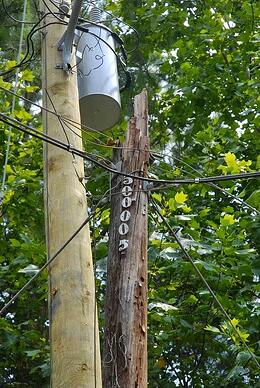The Joint Use Violation Most Wanted List, #1 – Aging Pole Transfers
 While there are dozens of issues and violations in the joint use world, there are a few we see so often we consider them problems of interest: repeat offenses to which no utility pole owner is immune. This blog is the second in a series detailing utility pole issues and the steps it takes to remedy them. Today, we kick things off with the most prevalent issue of all: aging pole transfers.
While there are dozens of issues and violations in the joint use world, there are a few we see so often we consider them problems of interest: repeat offenses to which no utility pole owner is immune. This blog is the second in a series detailing utility pole issues and the steps it takes to remedy them. Today, we kick things off with the most prevalent issue of all: aging pole transfers.
It starts with double wood
Double poles or “wood” is a problem we have discussed before, but to recap, double wood is a situation where two utility poles end up standing where there should only be one. This is problematic for a couple of reasons. First, if a pole was slated for removal because it was damaged or rotten, leaving it standing can be a danger and a liability. If a damaged or rotten were to fall and cause damage, the pole owner is responsible. Secondly, local governments and the public often see double wood as an eyesore or, in the case of double poles in the city, a pedestrian and biking hazard. The bottom line: no one likes them. Everyone wants attachments transferred from the old pole to the new one and the old pole removed as quickly as possible.
What creates this issue?
Double wood and the lagging pole transfers that cause it are often predicated by a lack of communication between pole owners and attachers. On the ownership side, data on the pole could be out of date, and current attachers may not be contacted to relocate their equipment in a timely manner. On the attachment side, backlogs can create delays, as can lack of notification that a piece of equipment needs to be moved.
What can be done?
The process of double pole removal has a few critical steps:
Check the Attachment Data
A record of who is attached to what pole, and whether or not a transfer has been made, is information that should be easily obtainable and accurate. If the pole owner has kept joint use records organized and up to date, this will be the case. Chances are, however, the data on file may not be current, so finding out for certain who to contact about equipment relocation is a big first step.
Conduct a Site Visit
If records on the pole or transfer are not current or are suspected of being incorrect, owners should perform an in-person site visit to determine next steps. Pole owners have a few options when it comes to this, and may either send someone from their in-house staff to visually survey the pole, or hire a third-party to perform the work. Either way, findings must be recorded accurately and kept on in a database, preferably in a robust joint use management system that makes retrieving the information easy.
Determine the Transfer Type
Prior to actually completing a pole transfer and removing a secondary, extraneous pole, someone must designate the type of transfer. Is it simple, complex, idle or already completed? Read about the various types of poles transfers here to learn more.
Get the Work Done
After a detailed assessment has been made, the type of transfer has been determined, attachers have been contacted and successfully removed their equipment, and all data has been recorded and stored, it is time to get to work removing the doubled pole.
How can you keep double poles from happening again?
Double poles happen frequently, and in a lot of cases remedying the situation—or ensuring it does not happen in the first place—is a matter of having the manpower to do the surveying, communicating and removal. Hiring additional staff is one way to go, contracting a third-party administrator to clear the backlog and keep ahead of new requests is another.
Again, good pole stewardship, communication with attachers and accurate record-keeping of pole and attachment status, is made more efficient and cost-effective through the use of a joint use management software solution.

Comments